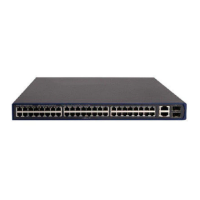95
NOTE:
• A VLAN can serve for only one mirroring group.
• When a VLAN is configured as a remote probe VLAN, you must remove the remote probe VLAN
configuration before deleting the VLAN.
• When you remove the configuration of a remote probe VLAN, an active mirroring group becomes
inactive.
• When a VLAN is configured as a remote probe VLAN, use the remote probe VLAN for port mirrorin
exclusively. Do not create a VLAN interface for the VLAN or confi
ure any other features for the VLAN.
• The remote mirroring groups on the source device and destination device must use the same remote
probe VLAN.
Configuring a remote destination group (on the destination
device)
To configure a remote destination group, make the following configurations on the destination device:
Creating a remote destination group
Follow these steps to create a remote destination group:
To do… Use the command… Remarks
Enter system view system-view —
Create a remote destination group
mirroring-group group-id
remote-destination
Required
By default, no remote destination
group exists on a device.
Configuring the monitor port for the remote destination group
You can configure the monitor port for a mirroring group in system view, or assign the current port to a
mirroring group as the monitor port in interface view. The two methods lead to the same result.
• Configuring the monitor port in system view
Follow these steps to configure the monitor port for the remote destination group in system view:
To do… Use the command… Remarks
Enter system view system-view —
Configure the monitor port
mirroring-group group-id
monitor-port monitor-port-id
Required
By default, no monitor port is configured
for a remote destination group.
• Configuring the monitor port in interface view
Follow these steps to configure the monitor port for the remote destination group in interface view:
To do… Use the command… Remarks
Enter system view system-view —
Enter interface view
interface interface-type
interface-number
—

